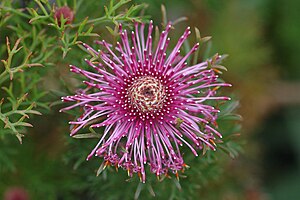Isopogon formosus
| Isopogon formosus | ||||||||||||
|---|---|---|---|---|---|---|---|---|---|---|---|---|

Isopogon formosus |
||||||||||||
| Systematics | ||||||||||||
|
||||||||||||
| Scientific name | ||||||||||||
| Isopogon formosus | ||||||||||||
| R.Br. |
Isopogon formosus (also known as "Rose Coneflower" in its Australian homeland) is a species of the silver tree family(Proteaceae).
description
Isopogon formosus is a bushy to slender, upright, evergreen shrub that reaches a maximum height of 2 m. Young shoots are light brown to reddish brown, silky, tomentose or with short hairs, later remaining smooth or fluffy. The stiff leaves, which arise in clusters, are up to 6 cm long (stem up to 2.5 cm, blade up to 3.5 cm). They are narrow-cylindrical, grooved, divided several times, segmented and taper to a sharp point. Young they are often silky hairy.
The pink to red-violet colored flowers appear from July to December and are in conical, conspicuous inflorescences up to 6 cm in diameter at the branch ends or in the upper leaf axils. The bracts are ovate to lanceolate, pointed and hairy. The single flowers reach up to 25 mm in length. When open, they tilt downwards. The tepals are bald except for a tuft of hair on the top of the head. The long stylus is initially light yellow and later turns reddish.
The fruits are egg-shaped, about 3 mm long, beaked and hairy nuts that contain a single seed.
Distribution and systematics
Isopogon formosus is in the southwestern Australia in a predominantly coastal areas endemic lying south of Perth as of Brusselton and the Stirling Range on Albany to the region around Esperance extends, so in a zone with Mediterranean Sclerophyll . The species thrives in sunny to partially shaded locations on well-drained, sandy to stony soils over laterite or granite . The species endures light frost and temporary dry periods, but no permanent moisture.
In Isopogon formosus two are subspecies distinguished, but can not be entirely separate clearly:
- Isopogon formosus subsp. formosus (leaves protruding, flowers up to 25 mm long)
- Isopogon formosus subsp. dasylepis (Meisn.) Foreman (overall smaller, leaves often closer together, flowers up to 20 mm long)
proof
Individual evidence
- ↑ Flora of Australia Online (English)
literature
- Margaret G. Corrick: Wildflowers of Southern Western Australia , 2009, Rosenberg Publishing, ISBN 978-1-877058-84-4 , p. 177
Web links
- Australian National Botanic Gardens: Isopogon formosus (English)
- Flora of Australia Online (English)
- FloraBase - the Western Australian Flora (English)